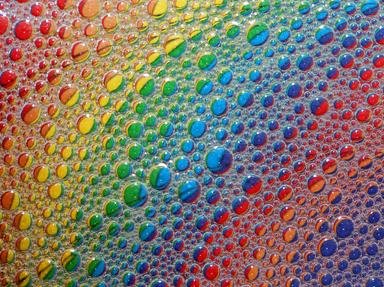Quiz Answer Key and Fun Facts
1. When a food coloring of this shade caused safety concerns in the 1990s, some companies replaced it with a natural dye made of crushed bugs. It's one of the three additive primary colors, and is the color of a badge that Stephen Crane wrote about. It was also the color of British uniform coats during the American Revolutionary War. What color is it?
2. Isaac Newton is credited with introducing this as one of the seven colors of the rainbow, but he may not have been referring to the same shade we do. It's also a mood of Duke Ellington, part of the name of a little North American songbird, and a plant-based dye. Look down! There's a chance you're wearing something dyed with it right now. What color is it?
3. This color can stand for cowardice in U.S. culture, but it has been the branch color of the U.S. Cavalry since before the American Civil War, and they certainly couldn't be accused of that. Someone also sang about a submarine that was this color. What is it?
4. Even if you can't see this color of the rainbow, it's still there on the inside of the arc, or at least the "near" version of this color is there. Usually called radiation rather than a color, this radiation from the sun helps people produce Vitamin D in their bodies, but also causes sunburns, skin cancer and cataracts. You can block it with sunscreen and sunglasses. "Black lights", used by dancers to make some colors glow fluorescent, also emit mostly this color. What color is it?
5. This is one of two colors Isaac Newton added to the rainbow when he expanded its five colors to the traditional seven. It's a fruit, but not often used as the last word of a line of poetry. Buddhists consider it symbolic of the highest stage of perfection, while Virginians in the U.S. consider it the name of a town and county in their state. What color is it?
6. This color is the name of a flower, and if you're shy, you might be called a "shrinking" one of them. It's also a color worn by bishops and archbishops in the Roman Catholic Church. Elizabeth Taylor's eyes were sometimes described as this color. What color is it?
7. Some people argue that Newton, who originally named the seven colors of the rainbow, actually meant plain old blue when he said "indigo", and actually meant this shade of blue when he said "blue". It's one of the three subtractive primary colors and is familiar to printers as part of the initials CMYK. Oxygen-deprived people whose skin is an unhealthy color suffer from this color plus the suffice "osis", and a well-known poison is this color followed by "ide". What color is it?
8. You can't see it, but this "color" of the rainbow, or at least a near version of it, exists in a weak band at the top of the arc. More commonly called radiation, it is used in night vision goggles and thermal imaging. Sir Frederick William Herschel discovered it in 1800 when he noticed light from a prism became hotter toward the red side, but was even hotter just beyond the red, where no visible light showed. What color is it?
9. This color, with an "s" on the end, describes a genre of music. It was the color of United States Army uniforms during the 19th century, and is still popular for police uniforms today. Despite its traditional association with sadness, some songs link it with happiness, such as the skies of this color that are "smiling at me" or the birds of this color that will be "over the white cliffs of Dover" when peace returns after World War II.
10. Shakespeare personified jealousy with eyes of this color, but today people often associate it with environmental awareness. In the U.S., it's the color of money, and it means "go" to drivers. What color is it?
Source: Author
littlepup
This quiz was reviewed by FunTrivia editor
Pagiedamon before going online.
Any errors found in FunTrivia content are routinely corrected through our feedback system.

